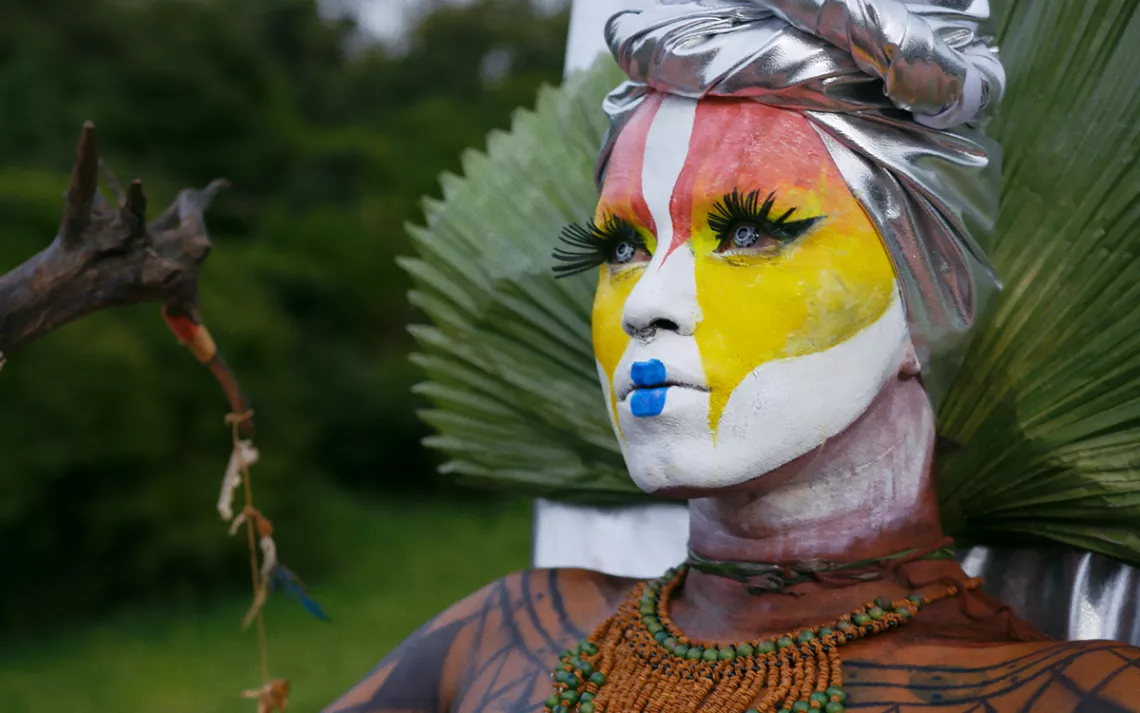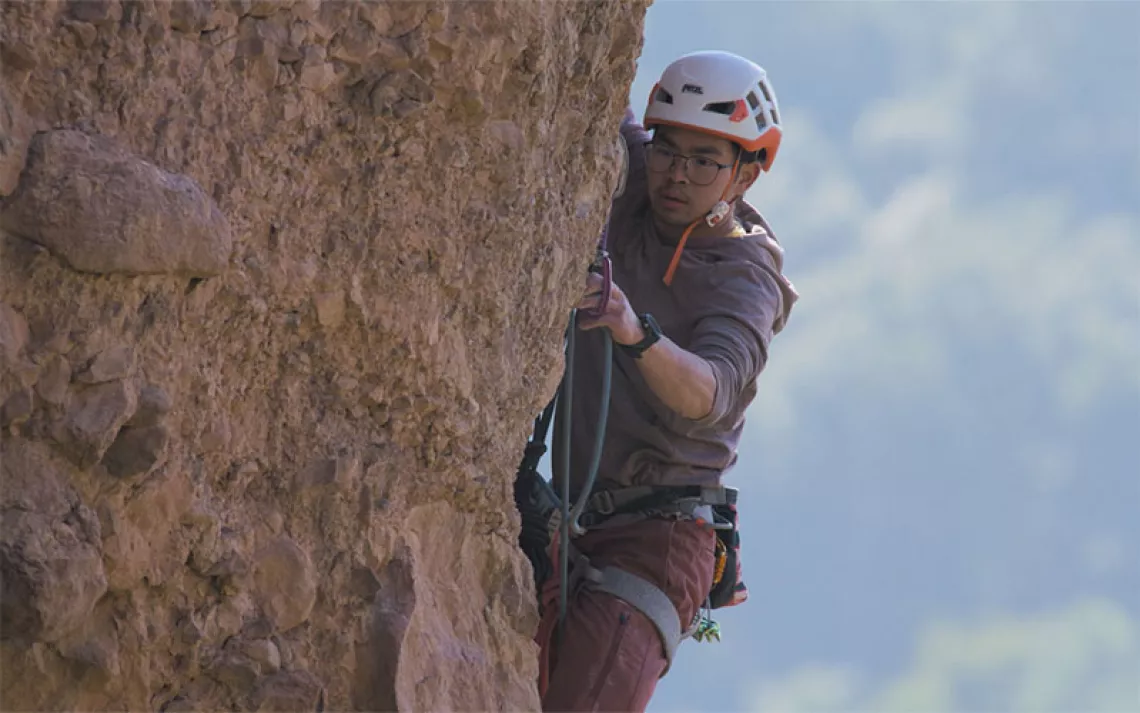What Is Queer Ecology?
Queer theory expands our relationship with nature

Indigenous nonbinary performance artist Uýra Sodoma is working to protect the Amazon rainforest. | Handout photo from the movie "Uýra the Rising Forest."
In recent decades, the traditional environmental movement has come under criticism for its reliance on fixed, binary categories—such as wild versus domestic and human versus nature—to guide conservation work. Those who study how humans interact with the outdoors say this mindset prevents caring for any beings, human or nonhuman, who aren’t easily categorized—including wild animals living in urban areas, Indigenous communities that live in close relationships with the outdoors, and people who identify as neither male nor female.
To better care for all beings, those in the environmental movement might have to think about the natural world much differently. Or, as some scholars say, they may have to queer their approach.
Queer ecology (or ecologies, to recognize the many people and cultures involved in this work) aims to break binaries and change how humans interact with the outdoors. First introduced by professor of environmental studies Cate Sandilands in 1994, queer ecology uses a practice called “queering”—which means, in part, to make something different or strange—to question the assumptions underlying concepts such as “wild” or “natural.” Queer ecologists strive toward a world in which human and nonhuman beings are less divided and more entangled and dependent on one another than ever.
“The way that we think about gender and sexuality directly informs how we think about the environment,” said Nicole Seymour, a professor of environmental humanities at California State University in Fullerton. “We have not thought about gender and sexuality in very liberatory ways in the past, and that has not been good for the nonhuman or for humans.”
The gender binary has climate implications too.
The natural world doesn’t fit neatly into binaries anyway. Myriad examples of queer animals exist, from homosexual mountain goats to gender-bending clownfish to asexual snakes. As writer Alex Johnson put it in an essay for Orion, “Observing queer behavior in nonhumans is as easy as a trip to the nearest primate house, or a careful observation of the street cats.” Johnson and other writers have suggested that the existence of these creatures offers to teach Western scientists and environmentalists that heterosexuality is far from the only “natural” way to exist.
The consequences of diverse animal sexualities can be very validating for LGBTQIA people, said Seymour. And, such findings show Earth’s great capacity for diversity, offering a fuller understanding of nature.
The gender binary has climate implications too. For example, the way that Western society has constructed the idea of “manhood” is closely related to fossil fuel consumption. To Seymour, US drivers’ obsession with large vehicles is evidence of an expression of masculinity that also threatens the planet. “They want to drive these vehicles that really announce to everybody, ‘I love using oil.'” If expectations for men were less tied to strength and the domination of nature, maybe people wouldn't reach toward fossil fuel usage as a way to prop up their gender identity, said Seymour.
Queer ecology (or ecologies, to recognize the many people and cultures involved in this work) aims to break binaries and change how humans interact with the outdoors.
“Queering” one’s relationship with nature can also mean exploring different forms of relationships that may have a lower environmental impact. For example, Seymour teaches her students that rejecting the single-family home is a practical example of queer ecology. Living situations that don’t center around one nuclear family in a suburban house often take up fewer resources, which is better for the planet.
“If you look at your average US or Canadian suburb, there are dwellings that are designed for nuclear families, that have yards and lawns and sprinkler systems and houses that are meant to shelter and nurture one family form. And other forms of family fit into that rather awkwardly,” said Sandilands. “Queering ecology means thinking clearly about the kinds of modes of family and conviviality that will usher in a more sustainable future.”
Parks are another example of a powerful site to apply queer ecological thinking. According to Sandilands, parks aren’t neutral spaces—rather, they’re built to promote certain behaviors, such as outdoor recreation, and eliminate other behaviors, such as Indigenous harvesting in national parks, or public sex in urban parks. “Parks tend to explicitly exclude activities that are considered antithetical to a moral order,” she said.
In 1997, two performance artists, Shawna Dempsey and Lorri Millan, turned that order on its head with the first installment of the Lesbian National Parks and Services at Banff National Park in Alberta, Canada. As lesbian park rangers, they asked park visitors to notice the absence of queerness in the park and in conservation efforts. “While you are in the park today, take the time to look around and question the heterosexual model. Ask yourself, What is nature?' Ask yourself, 'What is natural?’ And please, be careful not to step on any lesbians,” read the brochure that Dempsey and Millan handed out.
Queer ecology has offerings for scientists who study the nonhuman world too, according to Cesar Estien, a PhD candidate at the University of California, Berkeley. There, Estien studies how cities influence the health and behavior of wildlife. He’s argued that his field, urban ecology, has much to gain from adopting a queer lens.
To Estien, queer ecology has a number of different effects on ecological science, including always considering how humans are deeply connected to and affected by ecosystems, removing the hierarchy that places humans above other species, and interrupting anthropocentric thinking. Approaching urban ecology with a queer lens means he thinks about cities as spaces not only for humans but also for animals.
“Seeing animals as these individuals that also participate in urban social life a bit more explicitly helps frame [new questions] like 'What are the consequences of discrimination and racist policies on urban life at large?'" he said.
For example, animals in urban settings are often referred to as pests, vermin, or a nuisance. To Estien, queer ecology asks researchers and managers to conceive of urban wildlife as cohabitants of the city—neither more or less deserving of a good life than us humans. “How do we shift our questions away from how to prevent animals from being in a certain space to instead thinking about creating better cities that have really good outcomes for both people and wildlife?” he said.
Queer theory alters how Estien interacts with his study species, the coyote, which he says is a curious and resourceful, rather than threatening and predatory, animal. A forthcoming academic article by Estien details how understanding urban coyotes as marginalized ecological beings can create a deeper understanding of their behavior.
If it all sounds ambiguous, that’s part of the point, to Estien. “I’m still grappling with how to leverage this for empirical work,” he said. “It's almost our second nature as humans to look at something and go, ‘What does this mean? And what can I take from it?’ But maybe sitting with just that feeling of ‘What does this do?’ is enough, and maybe that can get us somewhere, eventually.”
For more queer ecology:
- Read about how Indigenous nonbinary performance artist Uýra Sodoma is working to protect the Amazon rainforest.
- Check out drag queen and activist Pattie Gonia, who works to make the outdoors inclusive and accessible for all.
- Listen to Estien talk about how queer ecology has impacted his relationship with his study subject: the urban coyote.
- Read this climate-fiction short story by writer Ada Patterson about an ecological disaster where only trans girls survive.
 The Magazine of The Sierra Club
The Magazine of The Sierra Club
